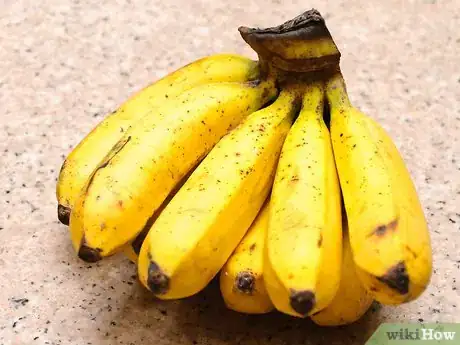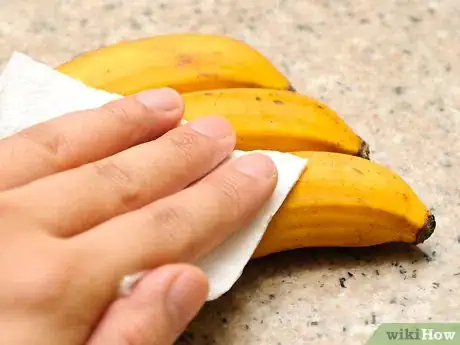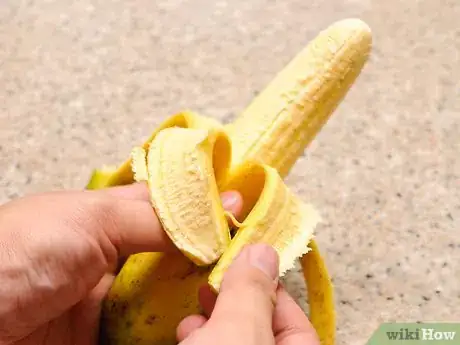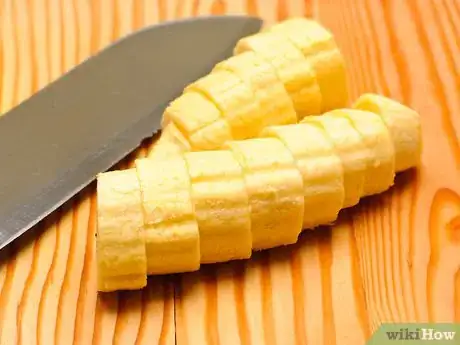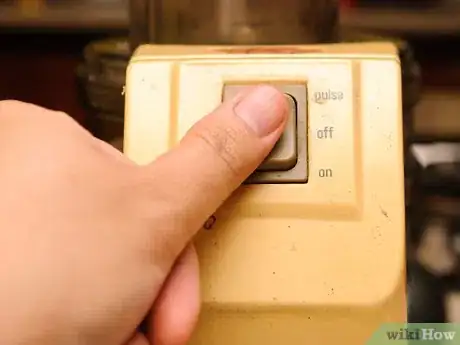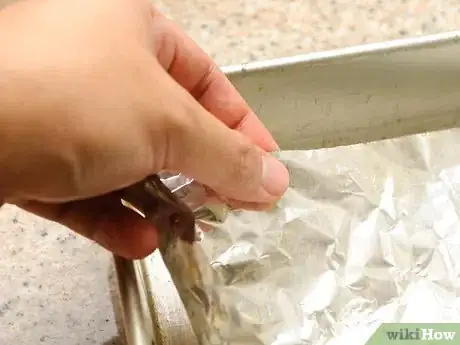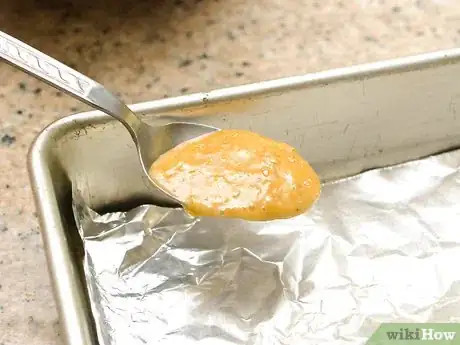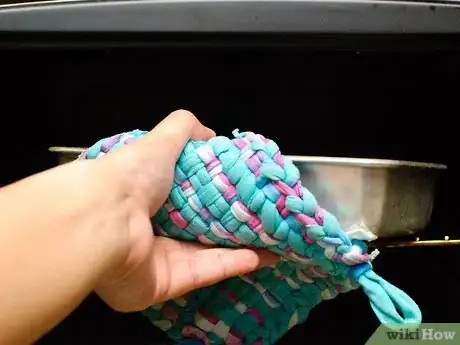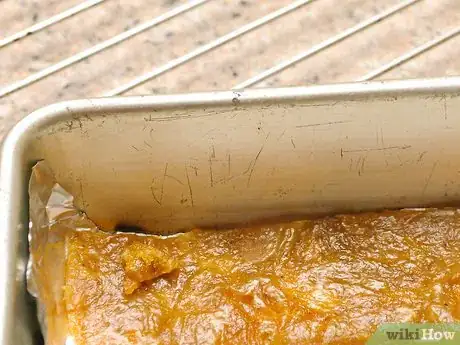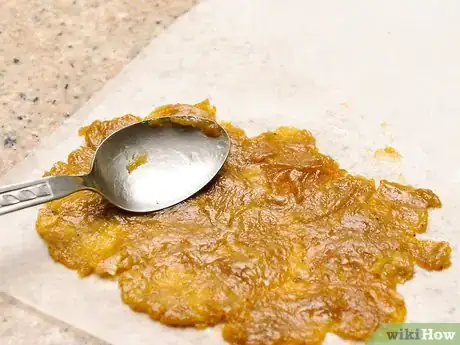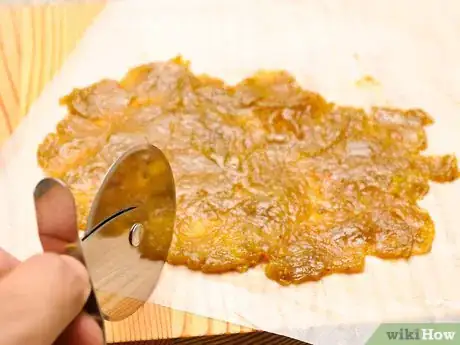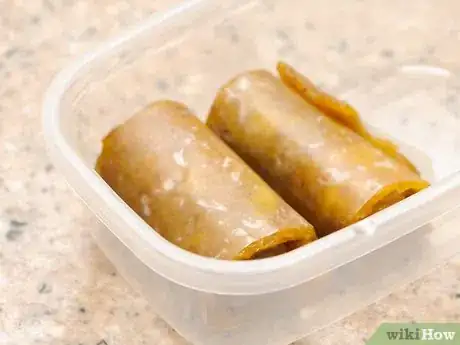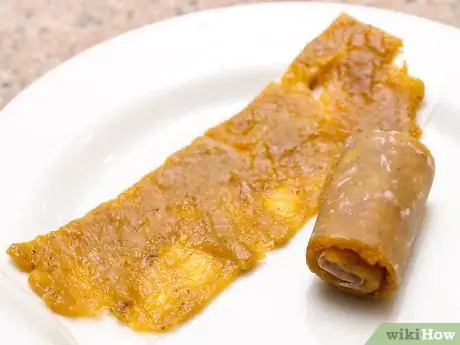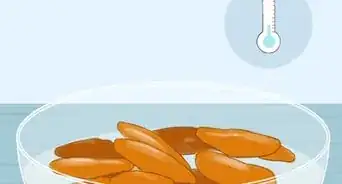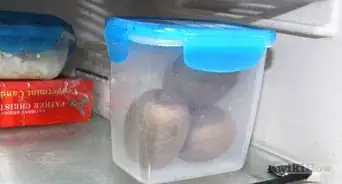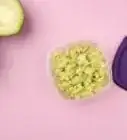This article was co-authored by wikiHow Staff. Our trained team of editors and researchers validate articles for accuracy and comprehensiveness. wikiHow's Content Management Team carefully monitors the work from our editorial staff to ensure that each article is backed by trusted research and meets our high quality standards.
This article has been viewed 22,782 times.
Learn more...
Fruit leather is a delicious, healthy alternative to commercially-made fruit snacks. With just a few ingredients, you can transform fruit into a fun, chewy snack your kids can take to school or enjoy at home. Choose your favorite fruity combination, then bake it or use a food dehydrator to turn it into chewy leather.
Ingredients
- 1 1/2 pounds chopped fruit of your choice
- 3/4 cup sugar
- 2 tablespoons lemon juice
Steps
Preparing the Fruit
-
1Choose your fruit. Fruit leather can be made with any type of fruit you want. Choose just one fruit, or pick your favorite combination to make custom-flavored fruit leather. You need a total of 1 1/2 pounds of fruit (not including the peels). These fruits shape up into delicious leather with the perfect texture:[1]
- Strawberries
- Grapes
- Plums
- Peaches
- Nectarines
- Pears
- Apples
- Mangoes
- Papayas
- Kiwis
- Bananas
-
2Wash the fruit thoroughly. It's important to wash away all traces of dirt and pesticides before you begin. Give each piece of fruit a thorough rinse under cool, running water. Let the fruit air dry or use a paper towel to pat it dry.Advertisement
-
3Peel the fruit if necessary. If you're using a fruit with a thick peel, you'll want to remove the peel before you dehydrate the fruit. The soft fruit inside the peel will dry out to just the right texture, but a dried peel could become too chewy to eat. If you're using any of the following fruits, peel first:
- Peaches
- Nectarines
- Pears
- Apples
- Mangoes
- Papayas
- Kiwis
- Bananas
-
4Chop the fruit into small pieces. The pieces don't have to be uniform; just small enough that you can weight them out them into your food processor. Use a sharp knife to chop the fruit, and remove any bruised areas.
-
5Process the fruit, sugar and lemon juice. Place the fruit, the sugar and the lemon juice in your food processor. Pulse the ingredients together until you have a smooth, lump-free puree. You may need to do this in batches.
- If you don't want to use sugar, try substituting honey, or half sugar, half honey as an alternative. Using honey will increase the time required to fully dry the fruit leather.
- If you don't have a food processor, a blender will do. Try to get the puree as smooth as possible, since lumps will hurt the texture of your fruit leather.
- The lemon juice acts as a flavor enhancer and natural preservative. Add more or less to taste.
Drying the Fruit Puree
-
1Preheat the oven to 200 °F (93 °C). Using a low, slow cooking method will give the puree time to completely dry out without burning.[2]
- If you own a food dehydrator, you can use that instead. The drying process takes longer but there's no risk of burning the fruit puree. The fruit puree prep process is the same for this method.
- Or try the microwave method, which also uses the same fruit puree prep process. Instead of using the oven, simply microwave the puree on a medium setting for five minutes, or until it has thoroughly dried. You'll have to do this in batches, since the entire recipe's worth of puree won't fit in the microwave.[3]
-
2Line a baking sheet with nonstick foil. You can also use a nonstick silicone mat. The fruit puree will stick to most other surfaces, so it's best to use a liner.[4]
- If you're using a food dehydrator, line the tray with nonstick foil.
- If you're using a microwave, do not use foil. Use a microwaveable nonstick mat or a microwavable nonstick tray.
-
3Spread the fruit puree in a thin layer on the baking sheet. The layer should be about 1/8-inch thick, so that your fruit leather will be perfectly chewy. If it's too thick, it will be difficult to chew; too thin, and it will turn out crispy instead of chewy.
-
4Bake the puree for three hours. Check on it after two and a half hours to see how it's progressing; in most cases it will still need more time. After three or so hours, it should be slightly tacky, just the right texture for fruit leather.
- If the fruit puree was on the dry side (as it would be if you used apples or bananas) it might be ready sooner than four hours.
- If you're using a dehydrator, it will take at least eight hours or overnight. Choose the correct setting according to the manufacturer's instructions.
- If you're using the microwave, the leather should be finished in five to six minutes.
- If you used a wet fruit, like strawberries or peaches, it might take longer than four hours.
-
5Let the fruit leather cool completely. If you try to handle it while it's still hot, it will fall apart and could cause a burn. Set it on a cooling rack and wait at least twenty minutes before handling.
- Check the underside of the fruit leather. If it's completely dry on both sides, it's finished. If it's still wet on the bottom, carefully flip the fruit leather over and return it to the oven for another hour or so to finish drying it out.
Slicing and Rolling the Leather
-
1Lay the cooled fruit leather on a sheet of waxed paper. This will prevent the leather from sticking to itself when you roll it up. Rolling up the fruit leather is a great way to store it for later.[5]
-
2Slice the fruit leather into strips. Use a pizza cutter or scissors to slice it into strips. Make sure you cut through the waxed paper, too. Make the strips as wide or as narrow as you'd like.
-
3Roll up the strips. Start at the narrow end of a strip of leather and roll it up, as you would a jelly roll. Keep going until the entire strip is rolled up with the waxed paper. Continue rolling the rest of the strips.
-
4Store leather rolls in an airtight container. The fruit leather will keep for up to a week.
-
5Finished.
Community Q&A
-
QuestionHow can I make sour fruit leather?
 Community AnswerSimply put sour fruit such as green apples into a food processor, pour the mixture into a baking sheet, and cook according to recipe instructions.
Community AnswerSimply put sour fruit such as green apples into a food processor, pour the mixture into a baking sheet, and cook according to recipe instructions. -
QuestionMy grapes are too watery. How do I fix this?
 Community AnswerYou could either try a different types of grapes or use another fruit entirely.
Community AnswerYou could either try a different types of grapes or use another fruit entirely. -
QuestionCan I make it without an oven?
 Community AnswerNo, it would not really work without an oven.
Community AnswerNo, it would not really work without an oven.
Things You'll Need
- Cookie sheet
References
- ↑ http://www.momables.com/how-to-make-fruit-leather/
- ↑ http://www.epicurious.com/recipes/food/views/strawberry-leather-242303
- ↑ http://www.food.com/recipe/quick-fruit-leather-79883
- ↑ http://www.foodnetwork.com/recipes/food-network-kitchens/fruit-leather-roll-ups-recipe.html
- ↑ http://www.foodnetwork.com/recipes/food-network-kitchens/fruit-leather-roll-ups-recipe.html
About This Article
To make your own fruit leather, start by preheating the oven to 200 degrees F and lining a baking sheet with nonstick foil. Next, chop the peeled fruit into small pieces and remove any bruised areas. Then, puree the fruit with sugar and lemon juice in a food processor. Spread the fruit puree on the baking sheet in a thin layer, about ⅛ inch thick. Bake the puree for 3 hours to 4 hours, then let it cool for 20 minutes before handling. To learn how to slice and roll up your fruit leather for easy storage, keep reading!
